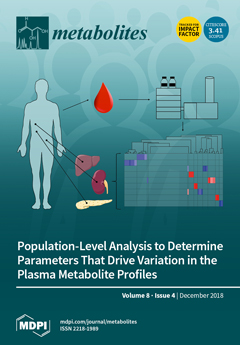It has become increasingly important to qualitatively and quantitatively assess the volatile metabolites in a range of bodily fluids for use in monitoring health. There has been relatively little work on the quantitative analysis of compounds, particularly with respect to the effects of ethnicity or geographic location. A novel method for the quantification of compounds in stool using
13C labelled compounds as internal standards is presented. Using thermal desorption gas chromatography mass spectrometry, stool samples from 38 healthy volunteers were analysed. The
13C labelled compounds, acetone, ethyl butanoate, ethanoic acid, butanoic acid, 3-methylbutanoic acid, and indole, were added as internal standards. This process mimics the solubility characteristics of the compounds and thus the method was able to quantify the compounds within the solid stool. In total, 15 compounds were quantified: Dimethyl sulphide (26–25,626 ng/g), acetone (442–3006 ng/g), ethyl butanoate (39–2468 ng/g), ethyl 2-methylbutanoate (0.3–180 ng/g), dimethyl disulphide (35–1303 ng/g), 1-octen-3-one (12 ng/g), dimethyl trisulphide (10–410 ng/g), 1-octen-3-ol (0.4–58 ng/g), ethanoic acid (672–12,963 ng/g), butanoic acid (2493–11,553 ng/g), 3-methylbutanoic acid (64–8262 ng/g), pentanoic acid (88–21,886 ng/g), indole (290–5477 ng/g), and 3-methyl indole (37–3483 ng/g). Moreover, by altering the pH of the stool to pH 13 in conjunction with the addition of
13C trimethylamine, the method was successful in detecting and quantifying trimethylamine for the first time in stool samples (range 40–5312 ng/g). Statistical analysis revealed that samples from U.K. origin had five significantly different compounds (ethyl butanoate, 1-octen-3-ol, ethanoic acid, butanoic acid, pentanoic acid, and indole) from those of South American origin. However, there were no significant differences between vegetarian and omnivore samples. These findings are supported by pre-existing literature evidence. Moreover, we have tentatively identified 12 compounds previously not reported as having been found in stool.
Full article






